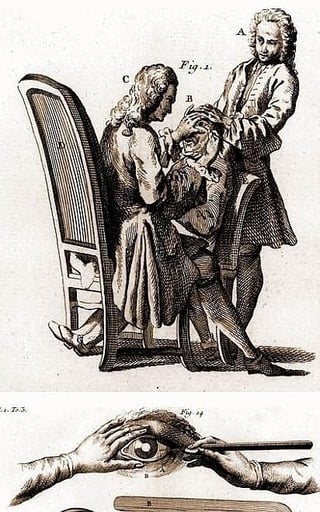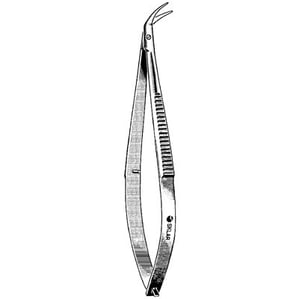The Early Years
What is known today as ophthalmology dates back to the Bronze Age. Initial written documentation regarding the eyes was recorded in 2250 B.C. Hammurabi, The king of Babylon, declared a series of laws with important instructions specifically directed to those who dared handle the eyes in a careless way. One entry reads: “If a man destroy the eye of another man, they shall destroy his eye.”1
In Egypt, the Ebers papyrus dating back to the year 1550 B.C. describes all the diseases and medical treatments that Egyptians were aware of the time. They knew about conditions such as cataracts, inflammation, granulation and dacryocystitis.2 While there is no evidence of surgery being performed at that time, history suggests that the Egyptian remedies worked, as Greek historians noted the king of Persia sought an ophthalmic recommendation from the king of Egypt.
Greek medicine was no different from the rest of the ancient period, which was plagued by superstitions, incantations and supernatural beliefs, and further medial progress was slow to come. Yet in the 17th century the works of Celsus had detailed descriptions on how to perform couching for cataracts. This technique relied on the use of a sharp instrument, like a needle, where the eye is pierced at the edge of the cornea, and the opaque lens is pushed down so that light can enter the eye. When the patient started seeing shapes, the procedure stopped and the needle was removed. Couching was, and still is, a dangerous procedure.  Even though around 70% of patients end up losing their sight, it is still practiced in Asia and Africa today.3 Ophthalmologic progress slowed again during the Middle Ages. Roger Bacon, however, made a notable contribution to ophthalmology with his work, Opus Majus. This book contains details in optical studies such as: the anatomy of the eye considering light, distance, position and size, direct and reflected vision, refraction, mirrors and lenses.4
Even though around 70% of patients end up losing their sight, it is still practiced in Asia and Africa today.3 Ophthalmologic progress slowed again during the Middle Ages. Roger Bacon, however, made a notable contribution to ophthalmology with his work, Opus Majus. This book contains details in optical studies such as: the anatomy of the eye considering light, distance, position and size, direct and reflected vision, refraction, mirrors and lenses.4
Couching Cataract surgery @ Public Domain
From the Renaissance to the 19th Century
The Renaissance did not contribute much to ophthalmology, save for Leonardo Da Vinci’s reasoning on the camera obscura and its parallel with the eye. It was not until the 18th and 19th centuries that further advances in ophthalmology were made possible by studying the eye’s anatomy in detail. Some landmarks in ophthalmic breakthrough for these latter centuries were:
- Georg Joseph Beer introduced Beer’s operation as cataract treatment.
- Baron Michael Jojann Baptist de Wenzel, the oculist of King George III, removed cataracts with great skill and legitimized the field.
- Hermann von Helmholtz invented the ophthalmoscope in1851.
- Moorfields Eye Hospital opened in London in 1805. It is still the largest eye hospital in the world.5
Contemporary Breakthrough
The ophthalmoscope of the mid19th century is what ultimately revolutionized the clinical study of the eye. This instrument allows ophthalmologists to see inside the fundus of the eye as part of a routine eye examination. It is crucial in determining the health conditions of the retina, optic disc and vitreous humor. The ophthalmoscope and further research in the field of ophthalmology opened the window for several eye doctors to subspecialize in particular diseases of the eye including cataracts, glaucoma, oncologic specialization and the cornea. The 20th century produced many outstanding ophthalmologists, including the following:
- Marshall Miller Parks – considered the father of pediatric ophthalmology. His studies in amblyopia and strabismus gave him world-wide reputation.
- Charles D. Kelman – devised the cryo-probe for cataract extraction and in 1975 began designing lens implants to use in cataract surgery.
- Sir Harold Ridley – the father of the intraocular lens. He was the first to create and implant this lens in a two-step procedure in 1950.
- Charles Schepens – deepened the study of the retina until it became a subspecialty of its own. He invented the indirect ophthalmoscope, still used to view the retina and is considered “the Father of Modern Retina Surgery” by raising the success rate of retinal reattachment surgery from 40% to 90%.
- José Barraquer – acknowledged as the father of refractive surgery. His work was focused on the idea of reshaping the cornea to change the eye’s refractive power, eventually leading way to LASIK surgery.
- Ramón Castroviejo – performed the first successful human cornea transplant. His success relied on the use of a rectangular “window” into the cornea. These rectangular windows gave better results because the edges could be fitted and merged to become a living part with the rest of the eye.6 He also promoted cornea donation and designed several ophthalmic instruments.7
Coincidently, one of Ramón Castroviejo’s first cornea transplant patients was named Sid Sklar, who was a young boy of 15 in 1941. Castroviejo diagnosed Sid’s problem as keratoconus, a rare condition at that time. He also explained that a procedure to restore his eyesight was possible, but it was still in an experimental stage. Since Sid had already lost his vision, he had nothing to lose. A few hours after his initial appointment, the cornea of a stillborn baby became available. There were no preservatives or eye banks at that time, so the surgery was performed under local anesthesia that same evening. In Sid’s own words:
“I remember lying there, listening to the doctor describe exactly what he was doing to a large group of international doctors who were present for the procedure. Since I had no vision, there was a gray nothing. As he removed the damaged cornea, everything became a velvet black. He prepared the square graft by measuring the opening and applied it. I couldn’t believe it, suddenly, I could see my doctor’s face with his surgical mask, and another doctor wearing a turban!”8
 Castroviejo later performed this surgery hundreds of times with an incredibly high success rate. Although the ophthalmic community did not recognize his success at first, he was revered for his sight-saving techniques and became the best known ophthalmologist of his time. Castroviejo received many honorary degrees from universities in Spain, Panama, Manila, Brazil and Peru. He was also a frequent speaker at medical meetings and a member of several professional societies in the United States.9 Castroviejo's Corneal Scissors
Castroviejo later performed this surgery hundreds of times with an incredibly high success rate. Although the ophthalmic community did not recognize his success at first, he was revered for his sight-saving techniques and became the best known ophthalmologist of his time. Castroviejo received many honorary degrees from universities in Spain, Panama, Manila, Brazil and Peru. He was also a frequent speaker at medical meetings and a member of several professional societies in the United States.9 Castroviejo's Corneal Scissors
Sklar is proud to offer several of Castroviejo’s surgical instruments. You may browse through these and many other high-quality ophthalmic instruments by clicking the button below.
References:
1 Wheeler, J.R., History of Ophthalmology Through The Ages (May, 1945).
2 History of Ophthalmology, Medical Research Council/Royal College of Ophthalmologists.
3 Meda, N; Bognounou, V; Seni, E; Daboue, A; Sanfo, O., "Cataract in Burkina Faso: Factors of choice between modern and traditional surgical procedures" (November, 2005).
4 Bacon, Roger.(1987). Bridges, John H. ed. The ‘Opus Majus’of Roger Bacon: Edited with Introduction and Analytical Table, Vols. I and II, Oxford: Horace Hart for the Clarendon Press (1987).
5 Smith, Yolanda, History of Ophthalmology, (News-medical.net, 2016).
6 Ramón Castroviejo, Developer of Cornea Transplant Procedures. (New York Times, January, 1987).
7 The American Society of Cataract and Refractive Surgery. (ACRS)
8 Thank You Baby – The Sid Sklar story, (National Keratoconus Foundation, February, 2009).
9 Polack, F.M., Ramon Castroviejo 1904-1987 (Cornea, September 19, 2000).



